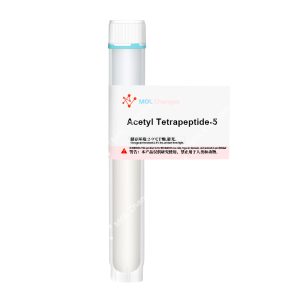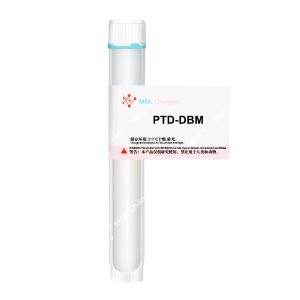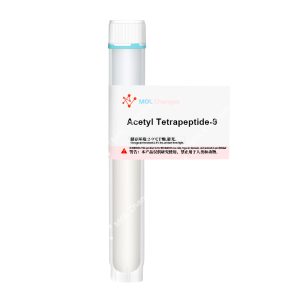Myristoyl pentapeptide-17 is a bioactive peptide specifically designed and synthesized to address the insufficient growth of natural eyelashes/hair.
Derived from a 14-18 amino acid fragment of human keratin-associated protein KAP5-1, it undergoes N-terminal myristoylation and C-terminal amidation; this enhances its half-life, allowing for direct penetration of human epidermal cell membranes.
Myristoyl pentapeptide-17 is currently one of the more potent cosmetic peptides used to stimulate eyelash growth, widely incorporated into numerous beauty products.
Sequence
Myr-Lys-Leu-Ala-Lys-Lys-NH2
CAS Number
959610-30-1
Molecular Formula
C41H81N9O6
Molecular Weight
796.14
Myristoyl Pentapeptide-17 Related Research
1.Primary Biological Mechanisms
Improved delivery efficiency of KGF, VEGF and lysophosphatidic acid (LPA) is facilitated within these cells, prolonging the hair growth cycle.
Anti-inflammatory properties are also exhibited, making it suitable for sparse eyebrows, and as an adjunct treatment of androgenetic alopecia; photoaging around the eyes being a primary concern.
Promoting follicular blood circulation is another key effect – enhanced blood flow to the hair follicles means increased nutrient and oxygen delivery, creating an ideal nutritional environment for eyelash growth.
2.Upregulation of keratin gene expression
The active fragment mentioned above retains the core function of the original KAP proteins.
Binding to cationic amino acid transporters, transcription and subsequent synthesis of KAP5-1 and Type I keratins (31 being the most well documented) is upregulated.
Thickening of the hair shaft cortex is the physical manifestation of this process, eyelash resilience being significantly increased.
3.Promoting microcirculation/nutrient supply
Myristoyl pentapeptide-17 stimulates keratinocytes to release VEGF-A and basic fibroblast growth factors.
Rapid membrane penetration leads to dermal microvessel vasodilation, improved blood flow, enhanced intercellular nutrient exchange and increased nutrient supply to the follicle.
Anti-inflammatory effects are all part of a larger, self-sustaining process of skin barrier repair.
Shortening the resting phase of the hair follicle and promoting eyelash health, is the end result of Myristoyl Pentapeptide-17’s actions.
COA
HPLC
MS

(1) HÖLzemann, G.; Löw, A.; Harting, J.; Greiner, H. E. Cyclic hexapeptide NK‐2 antagonists. International Journal of Peptide and Protein Research 2009, 44 (2), 105-111. DOI: 10.1111/j.1399-3011.1994.tb00564.x.
(2) Potvin-Fournier, K.; Valois-Paillard, G.; Lefèvre, T.; Cantin, L.; Salesse, C.; Auger, M. Membrane fluidity is a driving force for recoverin myristoyl immobilization in zwitterionic lipids. Biochemical and Biophysical Research Communications 2017, 490 (4), 1268-1273. DOI: 10.1016/j.bbrc.2017.07.005.
(3) Ueda, E.; Tamura, Y.; Sakaue, H.; Kawano, S.; Kakuta, C.; Matsumoto, S.; Endo, T. Myristoyl group-aided protein import into the mitochondrial intermembrane space. Scientific Reports 2019, 9 (1). DOI: 10.1038/s41598-018-38016-1.
(4) Varughese, K. I.; Aimoto, S.; Kartha, G. Calcium binding cyclic hexapeptide. International Journal of Peptide and Protein Research 2009, 27 (2), 118-122. DOI: 10.1111/j.1399-3011.1986.tb01800.x.








Reviews
There are no reviews yet.